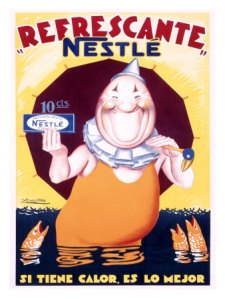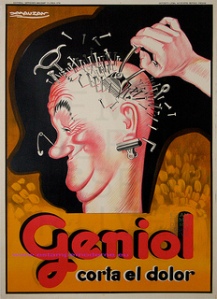French, b. Gap



















































































































After studying painting at the Lyon Academy, Mauzan moved to Italy in 1905 where he began a career as an illustrator. Four years later he was designing posters for the film industry in Turin. Ricordi picked him up in 1912 and then he moved on to Magagnoli’s Magical press in 1919. By the 1920’s his style had been greatly influenced by Cubism and Art Deco. The success of his poster designs allowed him to set up his own publishing house in 1924, the Mauzan-Morzonty Agency in Milan. With this success behind him he moved to Argentina in 1926 to establish Affiches Mauzan, a second publishing house in Buenos Aires. Four years later he expanded his business by establishing a new poster department for the Cosmos advertising agency. He returned to Italy in 1932 to see his dying wife, and then moved to Paris the following year. Before returning exclusively to painting in 1939, Mauzan had designed over 2,000 posters, many of which were reproduced on at least 1,000 postcards.
Achille Lucien Mauzan (1883, in Gap, Hautes-Alpes – 1952, in Gap) was born on the French Riviera, but moved to Italy in 1905, known as a decorative illustrator designing during the Art Deco movement, though he also painted and sculpted.
After a period of study in the École des Beaux-Arts at Lyon, France, Mauzan divided his life between Milan, Paris and Buenos Aires. Between the years 1920 and 1940, the period between the wars, he used forms and materials under the influence of the avant-garde cubists. He was also an illustrator of posters and postcards.
During his career as a poster printer and designer, Mauzan designed over 2,000 posters, using a style marked by humor and brilliant colors for advertisement and events and over 1,000 postcard images. He made several important posters for the Italian film industry in Turin, and then went to work at Ricordi music publishing from 1912 to 1917. Later, from 1919 to 1923 he works in the Magical press (Giovanni Magagnoli). In 1924 in Milan he establishes with Morzenti his own publishing house, the Mauzan-Morzenti Agency. In 1926 he travels to Argentina and sets up the “Affiches Mauzan” (Mauzan Posters) publishing house where many of his greatest works were created and where he worked until 1932. Within those years, Gino Boccasile, one of his students in Milan, travels to Argentina at his insistence and sets up studio. Mauzan is also noted for designing several war posters including an adaptation of the famous Lord Kitchener poster.
Spotlight Artists: Art Deco Individual, Achille Mauzan
Achille Luciano Mauzan was born along the French Riviera in Mereuil, France, in 1883. As a young boy, Mauzan, the son of school teachers, already displayed clear talent in the arts, spending his days filling his workbooks with caricatures and lively illustrations. In the early 1900’s, the artist moved to Milan, all while the same time the world was witnessing the birth of cinema. While mainly versed in painting and sculpting, Mauzan quickly immersed himself in the new art and in a very short time began to monopolize almost all the poster work from the Italian film industry. Due to the speed at which cinematic posters had to be produced, Mauzan found the need to simplify the lithographic process. Rather than creating sketches or maquettes, Mauzan would engrave directly onto the limestone or zinc plate, showing no signs whatsoever of his inexperience in this difficult process.
In 1917, Mauzan’s career escalated to the next level as he released his famous poster for Italian War Bonds. The image was a sensation overnight and essentially became the logo of the allies in the Great War. After the war ended, Mauzan returned to his love of advertising art, creating images for companies such as “Nestle,” “Fernet Branca,” and “Campari” in the 1920’s.
Stylistically, Mauzan shied away from the mainstream marketing tool of bright and cheery graphics. His images took a slightly darker and richer approach than most of his contemporaries in the Art Deco period, using heavy and overly emphasized facial and body features to warp his characters into some of the most brooding and emotionally expressive of the era. Exhibiting a twist of menace and sometimes a slight “spook” factor, Mauzan’s social approval continued to rise and he became a commissioned artist in high demand.
In 1923, he founded his own publishing house “Mauzan – Morzenti,” in Milan, Italy. It was at this publishing house that many young artists, including the well-known Gino Boccasile, got their start. Out of Mauzan – Morzenti came one of the artists’ greatest successes: his “Bertozzi” poster, a piece that highlights his clear talent and unique spirit as a great Art Deco illustrative artist.
A few years later, Mauzan moved to Buenos Aires and opened his second publishing house, “Affiches Mauzan.” It was in Argentina that much of the rest of his poster career took place, as he engrained himself in the South American art culture, where his reputation still remains in super stardom. Five years later, in 1932, Mauzan returned to Italy to be with his ill wife. Although he continued to produce posters sporadically, much of his luster and endurance in the art was gone, as many other deco artists dominated the markets’ attention.
During the advertising gap of World War II, Mauzan retired from the poster business entirely, focusing solely on his first love: painting.
Although he designed hundreds of posters, much of his work is very difficult to find today. Unfortunately many of his pieces from his famed career overseas in Buenos Aires did not survive, while his pieces from his brief European career have been so heavily collected that access to them today is very limited.
















Geen opmerkingen:
Een reactie posten